“Human beings have always been myth makers.”1
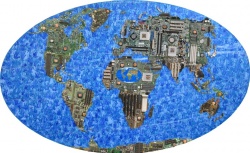
Réquiem a Gaia - In Totum II
When Walter Miranda writes that, with his paintings, he tries to get together emotion and reason, he is being a reductionist.
In fact, as much as he synthesizes in plastic works, in a prolix way I analyze his works by thoughts and try to express in words. The visual symbol expresses immediately, far beyond what the word enables (The eternal Indian dilemma name versus form
Thanks to fraternal influences, I have always liked mythologies, and by studying its structure I became aware that Walter is a narrator of myths. So let's get some definitions: What is Myth?
Myth plays an indispensable function; it expresses, upholds, and encodes belief, safeguards and imposes moral principles, guarantees the efficacy of ritual, and offers practical rules for the guidance of man. Myth, therefore, is a vital ingredient of human civilization.
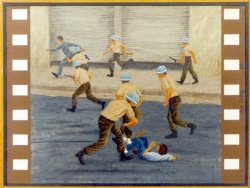
São Bernardo do Campo - Prova de Contato III
Now to the facts: Walter has a devotion to life and to the planet. He works constantly with philosophical questions expressed in pictorial symbols, but also musical, cinematographic, literary and religious, pictorially reinterpreted (it is enough to see the amount of references in his works)
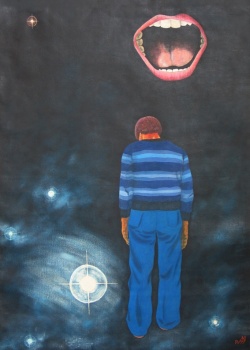
Esperança é a Ùltima que Morre
From his first series he deals with the myth of the hero, of the defenders of democracy, of freedom of expression, of citizenship. He himself is the hero in his 1977 work, "Hope is the Last that Dies." In its ecological phase, it tells the myths of Seattle Chief, the Brave New World, the Big Brother of 1984, all these are both myths of creation and eschatological, or extinction. His works speak of the "perennial philosophy" that gives meaning to the unattainable human experience: universal justice; unconditional compassion; hope for the eternal renewal of humanity; risk of physical extinction; cultural and species; the mystical gnosis of consciousness and action.
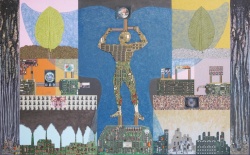
Projeto Seattle: Exaltação a Gaia - Nada de Novo no Front III com Alma
When I wrote the "Fruition of the Look about the artistic production of Walter," I had no notion of the dimension of strong time, that Mircea Eliade (2007) refers to. In that text I have told, unknowingly, about Sacred Time, the time that stops with contemplation and which at the same time is renewed at every glance. When walking through the work for a time without beginning and without end (since work closes a cycle in itself), one lives and relives the history narrated in the work. Each time we apprehend a new detail we re-actualize the pictorial myth. This is a "religious" experience, magical and sacred, it is esoteric, because it leads us to reflect on our behavior and on the paradigms of our actions. It is an ontological (self-seeking) and soteriological (salvation) myth. It does not deal with the history of the world only, but it deals with how I, Human being, deal with this world. Like me, homo "technologicus", I've gotten rid of my actions. The ritual of the "Fruition of the Look" of the Walterian works brings us closer to the extreme, from what is beyond expression and recounts the myth of extinction, the Christian millenarianism, which promises the eternal return to origin, of the ideal resumption.
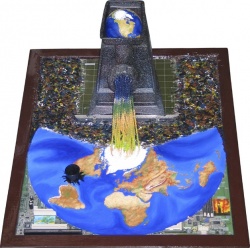
Máquina do Juizo Final
The myths of the series the Brave New World, Old and Future (again the millenium) are cosmogonic, transports us to a magical re-creation of the world so that by recounting our successes and failures, we can heal our contemporary wounds, of rationally technological abuses.
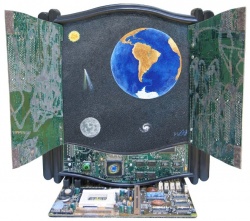
Oratório II
Walter sacralizes the Earth! He invokes it pictorially and liturgically in almost every painting. The various oratories, books, exaltations to Earth are three-dimensional prayers. In the series Requiem to Gaia, produced between 2007 and 2018, he tells us about the sacrilege of forgetting the planet as the source of life. As if inverting the Sanskrit philosophy (Samkhya), that in distinguishing the Self (Purusha) of Nature (Prakrti), the true knowledge would reside in Nature itself. In this way he takes up the monistic worship of the Mother Goddess who is the Self and is Nature. The Goddess Gaia, Earth, is generous with her creation and can also be a dangerous primitive force by returning to Axis Mundi.
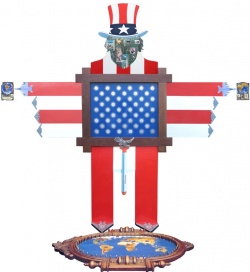
Doutrina Bush - O Espantalho da Morte
The mythological narratives of Walter Miranda's works contradict the initiation of contemporary pseudo-inventions, for it has an accessible narrative. Although it is epic, it does not bring the redemptive difficulty that only the chosen ones of the intelligentsia will accede. Perhaps Walter tired of the incontestable fables of reason, bring the truth of the sacred accessible. I think that here is your innovation of Art. The Renaissance and the epiphany of contemporary artistic mythology that foretells the lenitive of the perspectives of extinction and emptiness of the 3rd millennium.
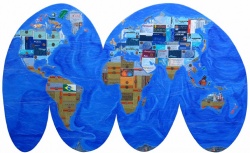
Réquiem a Gaia - Estigma do Chefe Seattle - Mundi I
1ARMSTRONG, Karen. Breve História do Mito. São Paulo: Companhia das Letras, 2005, pg 7. 2 ELIADE, Mircea. Mito e Realidade. 2a reimpr. da 6a ed. São Paulo. Perspectiva. 2007, pg 23 http://flaviaventurolimiranda.blogspot.com.br/2010/07/mitologias-artisticas-de-walter-miranda.html
2ELIADE, Mircea. Mito e Realidade. 2ª reimpressão da 6ª ed. São Paulo: Perspectiva, 2007, pg 23.
According to Armstrong (2005, pg 9 and 10), myth is characterized by 5 aspects:
1. It is based on the fear of death and extinction,
2. is accompanied by ritual, sacrifice, liturgy that vivifies him;
3. deals with extremes, invokes the beyond (time, space, world, life, man, word, reason);
4. must be acted upon to be seized and incorporated to take effect;
5. speaks to us of "perennial philosophy" and gives meaning to the unattainable of human experience.
For Eliade, the myth tells a 'true story' that is too sacred. "It is this irruption of the sacred that underlies the world and converts it into what it is today." The myth deals with
1. history of supernatural beings
2. true and sacred history - strong, sacred, therefore eternal time
3. refers to the creation as a pattern of behavior and paradigms for actions
4. knowledge of the primal and non-external origin of the world - return to origin
5. "live" the myth, remembering or re-updating - esoteric, magico-religious knowledge







